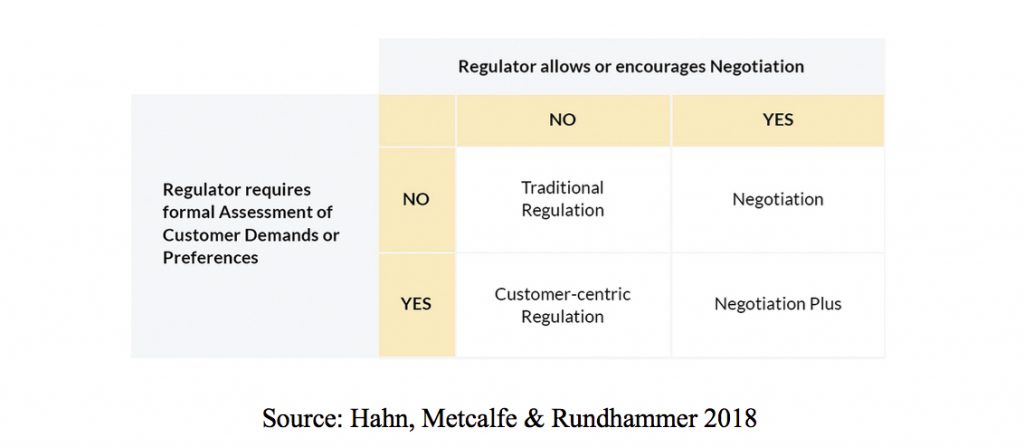Social Valuation: promoting customers engagement and empowerment with regulators and regulation
FSR Topic of the Month
Regulatory Delivery: Better governance for the Global Energy Transition
How could regulators promote the engagement of customers or civil society organisations in their decision-making process? Are costumers reacting to the incentives for demand response and, if not, how to revert their inertia? Are customers indeed receiving and perceiving the benefits of regulation? Do they have easy access to disputes resolution bodies in case of non-compliance?
During the last decade, the engagement of final customers – large industries, small and medium enterprises, and householders – with regulatory agencies has become a central part of modern utility regulation. Moreover, this engagement is pursued in different stages of regulatory governance. More and more regulators are interested in promoting the engagement of final customers in the making, implementation, monitoring, enforcement, and feedback of policies and regulations. For instance, customers have been asked about their preference of adopting cost-reflective distribution tariffs in the decision-making process, e.g. whether they’d rather go for fixed or off-peak network tariff prices. If the latter option is adopted, the implementation of the regulatory policy then depends on the de facto response of customers to the price variation. Whenever utility companies fail in providing timing or precise information to the effectiveness of the demand-response mechanism, customers are in the best position to identify non-compliances and act in the deterrence of wrongdoings.
Identifying governance modes to enhance the engagement of customers with regulatory agencies is not trivial. The second instalment of our topic of the month, therefore, gives a glimpse of how the promotion of customers engagement has been discussed in (1) decision-making, and (2) implementation of policies and regulations.
- Customer engagement: from regulator-focused to customer-focused decision-making
The integration of customers’ preference in the regulatory process is not a new phenomenon. Regulators have long been balancing the needs of utility firms with the need of customers to regulate price and/or quality of services. This, however, is not an easy task (Kahn 1970/1971; Joskow & Noll 1981). While the former is usually measured according to the cost structure of the firms, the latter is based on an estimation of customers’ willingness to pay for various services. The limited access to information about customers capacity, therefore, is a serious challenge to the balance of different market participants’ needs. Furthermore, in many cases, the objectives of the regulator towards customers are not well specified in legislation. For example, regulators mandates often include the obligation of observing the “public interest,” but does not clearly define what it means.
Throughout the last decades, regulators have largely employed two general regulatory models as a mean to satisfy the public interest. The first is the model in which firms are allowed to achieve a reasonable rate of return for their investments. Regulators set prices to recover the costs of services, which is generally referred to as the “rate-of-return regulation” (Kahn 1970/1971; Joskow & Schmalensee 1986). The second model is known as a “price cap-regulation” (Littlechild 1983). Unlike the rate-of-return, regulators set a price limit on a service or a group of service for particularly utility based on the “RPI-X formula”. The formula then considers inflation and an average expected efficiency gain to set prices, which imposes an incentive on utility firms to pursue the expected efficiency gains as a goal. In spite of the differences between rate-of-return and price-cap regulations, both regulatory models are similar in one aspect. They are regulator-focused, meaning their calculation is based on the assumption of customers’ willingness to pay, which is now adapted through a new a paradigm shift from regulator-focused toward more customer-focused regulation (Littlechild 2014; Bush & Earwaker 2015; Heims & Lodge 2016).
Customer-focused regulation is a model that encourages direct engagement with customers to identify their preferences. Harn, Metcalfe & Rundhamer (2018) identify two regulatory choices associated with customer-focused regulation, which are distinguished by the labels “negotiation” and “customer-centric regulation” (Figure 1). Under negotiation, regulators would encourage utility firms to negotiate a deal directly – e.g. regulated prices – with customers representatives, unions, or environmental associations. Regulators would then intervene in the price review if no deal reached. With the customer-centric regulation, instead, regulators remain to hold the obligation of determining the prices and terms of service, but it would do so after the firm engages with customers and presents its findings formally to the regulator as part of its business plan or rate case testimony.

Either “negotiation” or “customer-centric regulation” requires a de facto engagement of utility services with customers. Regulators would then have to assess the quality of the engagement’s strategies of the utility firm towards their customers such as online surveys, focus groups, consultation, or acceptability research.
- Customer Empowerment, information paradigm, and demand-side response
While customer engagement refers to public participation in the decision-making of regulators, customer empowerment plays a different role. Costumer empowerment emphasises the role of regulation to ensure end-users access to information with a certain purpose (Howells 2005). The purpose, therefore, is the expectation that customers would respond to information – i.e. demand-side response – and behave in a way that converges to the accomplishment of regulatory policies. In other words, consumer empowerment instrumentalizes customers to the accomplishment of policy goals that go beyond the information disclosure per se.
Customer empowerment is a new paradigm in consumer policy. It expands the scope of consumer policy centred on consumer protection towards their empowerment. Therefore, consumer protection and empowerment are not mutually exclusive. On the contrary, they are complementary. For instance, to ensure competition at the retail level, regulators need to protect customers against abusive clauses that preclude them switching supplier through imposing a contractual impediment – e.g. unreasonable cancellation penalties. On the other hand, regulators should also ensure that customers access suppliers price information – e.g. price comparative tools – to have incentives to switch suppliers. If consumers do not react to price incentives instead, it would compromise the competition at the retail level. Currently, the latter outcome is the current concern of regulators.
There is growing awareness and concern from regulators and policy-makers about the overestimation of the customer’s rational behaviour, in particular, householders (Stagnaro 2019). Some customer empowerment initiatives have not accomplished their purpose simply because of the lack of demand-side response. Until now, annual switching rates have remained low in most in the European Union, even in some Member States where the potential gains from switching are substantial. The European average is 6-8% for both electricity and gas. Savings from customers’ response to price variations is lower the expected, even in the Member States that installed in smart meters.
Answering how to overcome the inertia of consumers and ensuring the effectiveness of customers empowerment is currently a one-million-dollar question (see the next FSR Regulatory Policy Workshop on “What’s in it for all of us? The new role(s) of consumers”). One of the prominent answers is the transformation of consumers into smart consumers: the use of artificial intelligence (AI) to read information and respond on behalf of customers. AI associated with batteries could allow consumers to storage-or-dispatch electricity in low-or-pick prices. Innovation will play an important role, although it is too early to predict what is coming next. It is time than to stand and stare.
Interested in this topic?
Register for our Online Course on Regulatory Delivery: Better governance for the Global Energy Transition on 7 October – 29 November 2019
References
Bush H, Earwaker J (2015) The Future Role of Customer and Stakeholder Engagement in the Water Industry. Report Ref. No. 15/CU/03/3. UK Water Industry Research, London.
Harn R, Metcalfe R & Rundhamer F (2018), Promoting customer engagement: A new trend in utility regulation. Regulation & Governance.
Heims E, Lodge M (2016a) Customer Engagement: Towards a New Era in Economic Regulation? In: Lodge M (ed) Customer Engagement in Regulation, Carr Discussion Paper No. 82, pp. 1–7. Centre for Analysis of Risk and Regulation, London School of Economics and Political Science, London.
Howells G (2005) The Potential and Limits of Consumer Empowerment by Information. 32 Journal of Law and Society 349.
Joskow PL, Noll RG (1981) Regulation in Theory and Practice: An Overview. In: Fromm G (ed) Studies in Public Regulation, pp. 1–78. MIT Press, Cambridge, MA.
Joskow PL, Schmalensee R (1986) Incentive Regulation for Electric Utilities. Yale Journal on Regulation 4(1), 1–49.
Kahn AE (1970/1971) The Economics of Regulation: Principles and Institutions. Volumes 1 & 2. MIT Press, Cambridge, MA.
Littlechild S (1983) Regulation of British Telecommunications’ Profitability: Report to the Secretary of State. Policy Report for the Secretary of State, Department of Industry, London.
Littlechild S (2014) RPI-X Competition as Rivalrous Discovery Process, and Customer Engagement. Utilities Policy 31, 152–161.
Stagnaro C (2019) Second-generation smart meter roll-out in Italy: A cost-benefit analysis, Power Summit 2019






